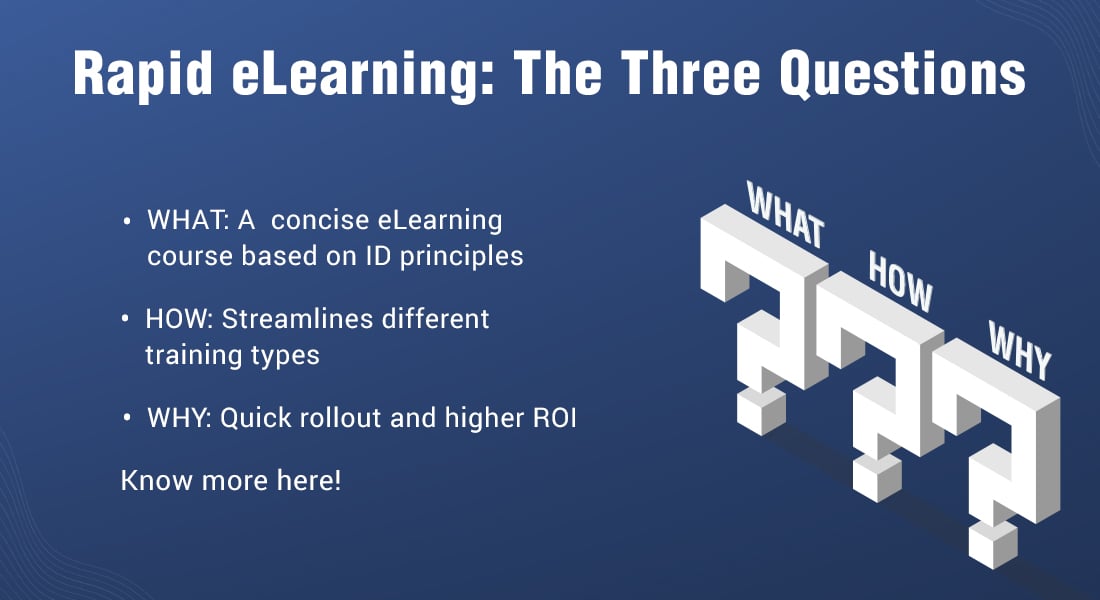10 Best Practices to Implement Rapid eLearning in Microlearning [Infographic]
![10 Best Practices to Implement Rapid eLearning in Microlearning [Infographic] 10 Best Practices to Implement Rapid eLearning in Microlearning [Infographic]](https://blog.commlabindia.com/hubfs/blogs/microlearning-best-practices-implement-rapid-elearning-info.jpg)
Considering the fast-paced business world and its workforce, it won’t be wrong to say that attention spans are shrinking and learning needs are constantly evolving. For such situations, traditional eLearning courses are often lengthy and cumbersome which leads to learner disengagement and hinders knowledge retention. Now that we understand the problem, our focus should be on finding the solution. Right? And the answer is easy: microlearning! It’s an effective training approach that focuses on delivering information as targeted, bite-sized nuggets.
Given the fast pace of the business world, the next challenge is how can you create these impactful microlearning modules quickly and efficiently? And we have yet another simple but effective answer: rapid eLearning.
In this blog, we’ll take a detailed look at the concept of rapid eLearning, its benefits for microlearning, ten best practices for implementing it successfully, and lastly explore the top 5 rapid authoring tools for microlearning development. So, let’s begin!
What is Rapid eLearning?
Rapid eLearning refers to the development of digital learning content using rapid authoring tools and techniques. Unlike traditional eLearning development, which often requires extensive time and resources, rapid eLearning streamlines the process and allows for quicker deployment of learning materials. Rapid eLearning leverages already existing training material and easy-to-use authoring tools that are home to pre-designed templates, multimedia assets and interactivities, a question bank for eLearning assessments, and a lot more. All these factors accelerate content creation without compromising quality.
→ Download Now: Where Does Microlearning Fit Into Your Learning Strategy?
Benefits of Rapid eLearning for Microlearning
- Agility: Rapid eLearning enables organizations to respond swiftly to training needs and market changes by developing and deploying bite-sized learning modules quickly.
- Cost-effectiveness: By reducing development time and resources, rapid eLearning lowers the overall cost of training initiatives, making it a budget-friendly option for organizations of all sizes.
- Accessibility: Microlearning modules developed through rapid eLearning can be easily accessed across various devices like laptops, mobile phones, computers, etc. It ensures that learners can engage with the content anytime, anywhere, thereby promoting continuous learning.
- Learner Engagement: The condensed format of microlearning combined with interactive elements enhances learner engagement and retention, leading to more effective learning outcomes.
- Customization: Rapid eLearning allows for easy customization and personalization of microlearning training content that helps cater to diverse learning styles, needs, and preferences.
10 Best Practices for Implementing Rapid eLearning for Microlearning
Top 3 Rapid Authoring Tools for Microlearning Development
There are various rapid eLearning authoring tools that facilitate the development of microlearning content. They offer multiple features like intuitive interfaces, drag-and-drop functionality, multimedia assets, pre-designed templates, etc., to streamline the microlearning development process.
Here’s a look at the popular rapid authoring tools for microlearning development.
- Articulate Storyline: Known for its user-friendly interface and robust features, Articulate Storyline enables developers to create interactive microlearning modules in a hassle-free manner.
- Adobe Captivate: Adobe Captivate offers a wide range of templates, themes, and interactive elements to help learning architects put together top-notch, impactful microlearning modules. Even better, these modules can be accessed on any device, at any time.
- Elucidat: This cloud-based authoring software with rapid authoring features makes it an ideal choice for teams working on rapid microlearning development projects. Microlearning course developers can benefit from its features such as PowerPoint upload, AI-driven course creation, screen and camera recording, and more.
To Sum It Up!
Rapid eLearning offers a streamlined approach to developing microlearning content. It enables organizations to deliver timely, engaging, and effective training solutions. Now that you know the best practices for implementing rapid eLearning for microlearning, you can maximize the impact and efficiency to achieve desired results and accomplish business goals successfully. Before you jump into leveraging rapid eLearning for microlearning development, it’s crucial to understand where does microlearning fit into your learning strategy. Here’s an eBook to help you find answers. Check it out below!






![5 Microlearning Benefits That Will Change Your Corporate Training Game [Video]](https://blog.commlabindia.com/hubfs/Imported_Blog_Media/microlearning-benefits-corporate-training-video.jpg)
